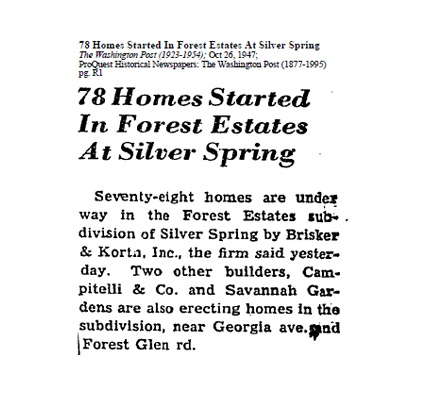The Whole Spiel
My Mezuzah
April 12, 2021
All of the places we live have a history. When I joined the staff of the Capital Jewish Museum this year, I started thinking about what kinds of Jewish histories are embedded in my own house and my own neighborhood, and how my own story intersects with the museum’s stories.
I have lived in Silver Spring for 20 years. Just north of the DC line in Montgomery County, Silver Spring has experienced massive growth in the last century. Back in the 1930s, the formerly rural area made way for new housing developments. Some of these had restrictive covenants–that is, only non-Jewish white people could buy homes there. When we bought this house, we were told that our neighborhood–Forest Estates–was developed by Jews specifically because Jewish buyers had been restricted elsewhere. While researching housing discrimination in DC and its suburbs, we have also found that some Jewish developers included restrictive covenants against African American buyers in various neighborhoods and new subdivisions. These were unenforceable after 1948, but housing discrimination continued well after that time, and continues to shape our residential patterns.

Lease between Henry Yost and Louis Epstein, 1926, for property at 1629 13th Street, NW. Includes an extra typewritten clause at the bottom specifying “this lease shall not be transferred or assigned to any person or persons of the African race or to any firm or corporation the members of or stockholders in are of the African race.” CJM Collection, Gift of Janet and Donald Brady.]
In 1945, Forest Glen Homes bought the land that is now my neighborhood from the Getty family, who had farmed here since 1883. This partnership included Leo Minskoff, Sadie Milestone, Philip Milestone, and a few others. These developers are easy to find in many Montgomery County records–they bought and sold subdivisions all over Silver Spring and Takoma Park in the 1930s and 1940s. The county awarded the permit to build on my street in 1951. The builders included Russian immigrant Nathan Brisker and Italian immigrant Anthony Campitelli, a familiar building team in the county.

The people who lived in my house (our house) for its first half-century, the Bisgyers, were Jewish, as were many people on our street, which I can tell from looking at the names in the Silver Spring directories. Many of them came to the area to work in a burgeoning civil service. In my house (our house) the husband worked for the State Department. The wife was a teacher at Montgomery County Public Schools (we found her ID card in the laundry chute). The couple raised their son here–and we raised our own son here, 50 years later. We bought the house when Edith Bisgyer–by then living alone–moved to the Hebrew Home in Rockville. I think of her every time I read in our exhibition script that the Hebrew Home, founded to serve elderly Jews in downtown DC in 1914, moved to Petworth in 1925 and then to the Rockville campus in 1969. She was part of the history of the Jewish community in Montgomery County–the developers, the growing numbers of middle-class homebuyers, the government workers, and the school system that started closing for the High Holidays while she worked there, because of all the Jewish teachers and students.

When we moved into this house, only its second occupants, there was already a mezuzah on the front doorway. I could have switched it out–for the one I got for my bat mitzvah, for the one I bought in Israel when I was in high school, for the one we got at our wedding. But we kept it there, always a reminder that our house has a history, and that it also, specifically precious to me, has a Jewish history.
